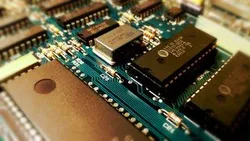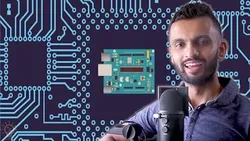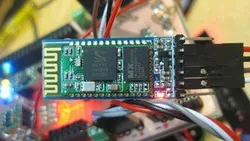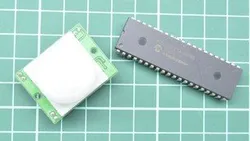
PIC18 Microcontroller: Step By Step Guide 
Enter the world of PIC18 Microcontrollers and learn how to program them like a champ. Understand the main differences between PIC16 and PIC18, and gain the skills to connect various components and sensors to your PIC Microcontroller. Get a comprehesive understanding of this course which is a cost course. AZ Class provides this course data for free. Learn more certificate and details here. ▼
ADVERTISEMENT
Course Feature
![]() Cost:
Cost:
Paid
![]() Provider:
Provider:
Udemy
![]() Certificate:
Certificate:
Paid Certification
![]() Language:
Language:
English
![]() Start Date:
Start Date:
On-Demand
Course Overview
❗The content presented here is sourced directly from Udemy platform. For comprehensive course details, including enrollment information, simply click on the 'Go to class' link on our website.
Updated in [October 18th, 2023]
What does this course tell?
(Please note that the following overview content is from the original platform)
You will enter PIC18 Microcontroller world Know the main differences between PIC16 and PIC18
What youll learn:
Program PIC Microcontroller like a champ
Understand the principles of programming micro-controllers
Understand and use many types of sensors and components
Connect your PIC Microcontroller to LCD Screen and control it
Connect your PIC Microcontroller to Seven Segment and control it
Connect your PIC Microcontroller to Motor and learn how to control it
Connect your PIC Microcontroller to Keypad and control it
Connect your PIC Microcontroller to DOT Matrix and control it
Use tools to build electronic devices
Understand basic principles in electronics design
Introduction:
The PIC18F product family also has an 8-bit CPU and offers extended performance over the PIC16F device family The PIC18F device family can operate at speeds up to 12 MIPS and has a hardware multiplier for faster calculation of control algorithms There are variants in the PIC18F family with specialized motor control peripherals including a 3-phase motor control PWM peripheral and a quadrature encoder interface (QEI) Other PIC18F variants have the ECCP module found in the PIC16F device family
Source code developed for the PIC16F device family can be easily migrated to the PIC18F family Devices with the motor control PWM module are well suited for variable-speed 3-phase motor applications while devices with the ECCP module are useful for brush DC and stepper motor applications
You will enter the
PIC18 Microcontroller world
Know the main differences between PIC16 and PIC18 when it is better to use PIC18 and what are the wiring and programming differences between PIC16 and PIC18
You should be familiar with the basics of PIC Programming using the MikroC compiler
There are a lot of
advantages for PIC 18F microcontrollers
compared to 16F And we will discuss these advantages and
why sometimes it's better to go with a PIC18
instead of a PIC16
Why you should take this course?
How to program PIC 18F Microcontrollers using the MikroC Pro compiler
The course will help you understand the main differences between PIC 16 and 18 and teach you how to program and upload a hex file to the device
You will learn how to connect power up and configure the PIC18 Microcontroller for programming
You will learn the differences in memory between PIC 16 and 18
You will learn how to set up an IDE
You will learn programming examples in assembly
Each section of this course is self-contained so that you can progress through it in any order that suits your needs
This course is designed to introduce the PIC18 Microcontroller hardware and programming environment to get you started on building projects as soon as possible
Unleash Your Inner Hero With this Course
PIC Microcontroller Inner structure and Programming Introduction
LEDs Resistors and Push buttons
DIY Projects and Quick Tips
This course is designed for anyone interested in learning electronic design No experience is required and all you need is PIC Microcontroller and several low-cost components
With hours of content in many lectures this course will take you from zero experience in electronics or programming to PIC Microcontroller Master
We considered the value of this course from many aspects, and finally summarized it for you from two aspects: skills and knowledge, and the people who benefit from it:
(Please note that our content is optimized through artificial intelligence tools and carefully reviewed by our editorial staff.)
What skills and knowledge will you acquire during this course?
During this course, the learner will acquire the following skills and knowledge:
1. Understanding the main differences between PIC16 and PIC18 microcontrollers.
2. Programming PIC microcontrollers using the MikroC Pro compiler.
3. Understanding the principles of programming microcontrollers.
4. Using various types of sensors and components.
5. Connecting a PIC microcontroller to an LCD screen and controlling it.
6. Connecting a PIC microcontroller to a seven-segment display and controlling it.
7. Connecting a PIC microcontroller to a motor and learning how to control it.
8. Connecting a PIC microcontroller to a keypad and controlling it.
9. Connecting a PIC microcontroller to a DOT matrix display and controlling it.
10. Using tools to build electronic devices.
11. Understanding basic principles in electronics design.
12. Familiarity with the basics of PIC programming using the MikroC compiler.
13. Understanding the advantages of PIC18F microcontrollers compared to PIC16F.
14. Programming examples in assembly language.
15. Setting up an IDE for PIC microcontroller programming.
16. Understanding the differences in memory between PIC16 and PIC18 microcontrollers.
17. Learning the inner structure and programming introduction of PIC microcontrollers.
18. Working with LEDs, resistors, and push buttons.
19. Building DIY projects and learning quick tips.
20. Developing skills in electronic design without any prior experience.
By the end of the course, the learner will have gained a comprehensive understanding of PIC18 microcontrollers and will be able to confidently program and work with them in various applications.
Who will benefit from this course?
Electronics Enthusiasts: People interested in entering the world of PIC18 microcontrollers, learning how to program them effectively, and exploring their applications in electronics projects.
Aspiring Embedded Systems Engineers: Students or individuals aiming to acquire knowledge and practical skills in programming microcontrollers and working with various electronic components.
DIY Hobbyists: Hobbyists and makers looking to enhance their understanding of microcontrollers and use them in do-it-yourself projects.
Electronics Design Enthusiasts: Those interested in the principles of electronics design and building electronic devices.
Students in Electrical and Electronics Engineering: Students pursuing degrees in electrical or electronics engineering who want to gain hands-on experience with PIC18 microcontrollers.
Professionals in the Electronics Industry: Individuals in the electronics industry looking to expand their knowledge of PIC18 microcontrollers and improve their programming skills.
Course Provider

Provider Udemy's Stats at AZClass
Discussion and Reviews
0.0 (Based on 0 reviews)
Explore Similar Online Courses

Build a full stack UBER EATS clone - 2&5 Days Challenge

HSE&GED&TASC&HiSET Prep: Math (Unit 2 - Word Problems)

Python for Informatics: Exploring Information

Social Network Analysis

Introduction to Systematic Review and Meta-Analysis

The Analytics Edge

DCO042 - Python For Informatics

Causal Diagrams: Draw Your Assumptions Before Your Conclusions

Whole genome sequencing of bacterial genomes - tools and applications

Fun and Easy Microcontroller Communication Protocols

Bluetooth module Interfacing with PIC Microcontroller


Start your review of PIC18 Microcontroller: Step By Step Guide